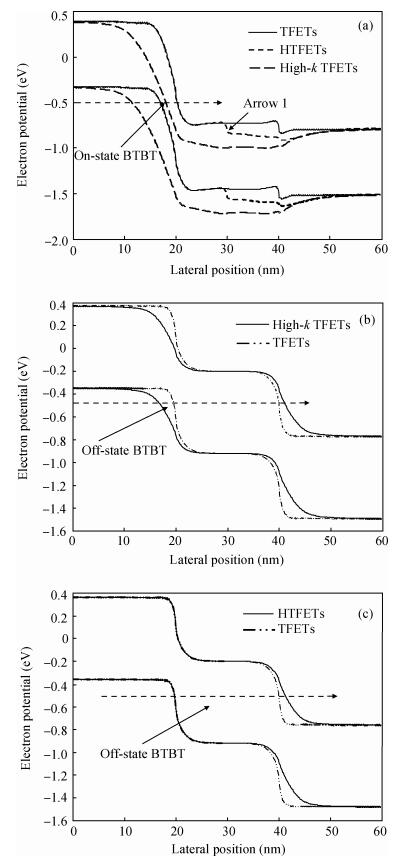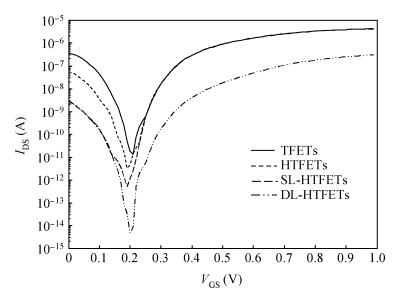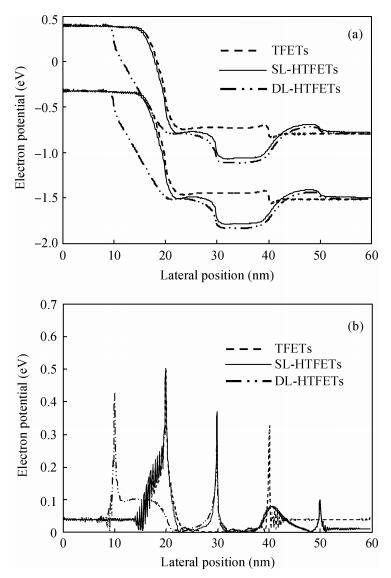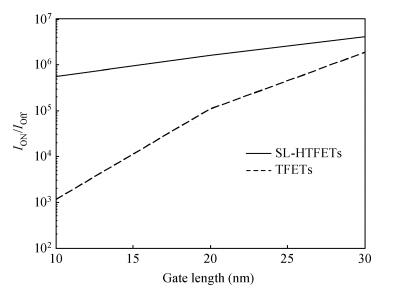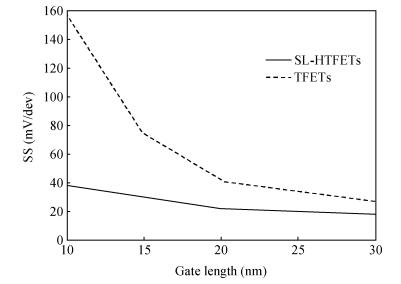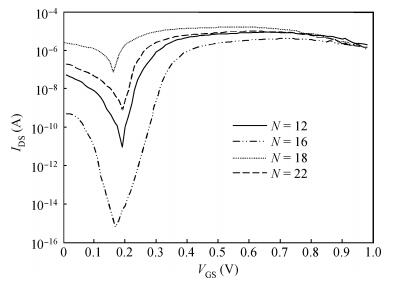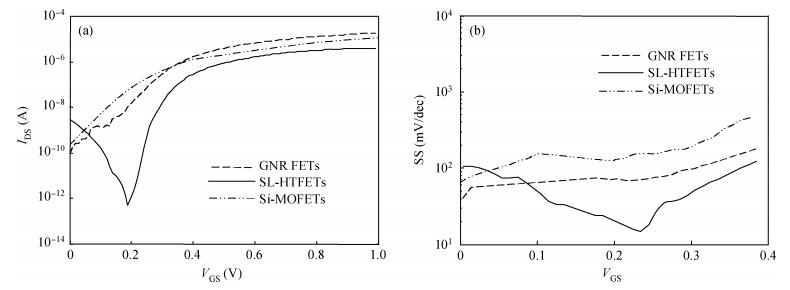| Citation: |
Wei Wang, Gongshu Yue, Xiao Yang, Lu Zhang, Ting Zhang. Quantum simulation study of double gate hetero gate dielectric and LDD doping graphene nanoribbon p-i-n tunneling FETs[J]. Journal of Semiconductors, 2014, 35(6): 064006. doi: 10.1088/1674-4926/35/6/064006
****
W Wang, G S Yue, X Yang, L Zhang, T Zhang. Quantum simulation study of double gate hetero gate dielectric and LDD doping graphene nanoribbon p-i-n tunneling FETs[J]. J. Semicond., 2014, 35(6): 064006. doi: 10.1088/1674-4926/35/6/064006.
|
Quantum simulation study of double gate hetero gate dielectric and LDD doping graphene nanoribbon p-i-n tunneling FETs
DOI: 10.1088/1674-4926/35/6/064006
More Information
-
Abstract
We perform a theoretical study of the effects of the lightly doped drain (LDD) and high-k dielectric on the performances of double gate p-i-n tunneling graphene nanoribbon field effect transistors (TFETs). The models are based on non-equilibrium Green's functions (NEGF) solved self-consistently with 3D-Poisson's equations. For the first time, hetero gate dielectric and single LDD TFETs (SL-HTFETs) are proposed and investigated. Simulation results show SL-HTFETs can effectively decrease leakage current, sub-threshold swing, and increase on-off current ratio compared to conventional TFETs and Si-based devices; the SL-HTFETs from the 3p + 1 family have better switching characteristics than those from the 3p family due to smaller effective masses of the former. In addition, comparison of scaled performances between SL-HTFETs and conventional TFETs show that SL-HTFETs have better scaling properties than the conventional TFETs, and thus could be promising devices for logic and ultra-low power applications. -
References
[1] Novoselov K S, Geim A K, Morozov S V, et al. Electric field effect in atomically thin carbon films. Science, 2004, 306(5696):666 doi: 10.1126/science.1102896[2] Li X L, Wang X R, Zhang L, et al. Chemically derived, ultrasmooth graphene nanoribbon semiconductors. Science, 2008, 319(5867):1229 doi: 10.1126/science.1150878[3] Geim A K. Graphene:status and prospects. Science, 2009, 324(5934):1530 doi: 10.1126/science.1158877[4] Castro N A H, Guinea F, Peres N M R, et al. The electronic properties of graphene. Rev Mod Phys, 2009, 81(1):109 doi: 10.1103/RevModPhys.81.109[5] Obradovic B, Kotlyar R, Heinz F, et al. Analysis of graphene nanoribbons as a channel material for field-effect transistors. Appl Phys Lett, 2006, 88(14):142102 doi: 10.1063/1.2191420[6] Chen Z, Lin Y M, Rooks M J, et al. Graphene nanoribbon electronics. Phys E, 2007, 40(2):228 doi: 10.1016/j.physe.2007.06.020[7] Brey L, Fertig H A. Electronic states of graphene nanoribbons studied with the Dirac equation. Phys Rev B, 2006, 73(23):235411 doi: 10.1103/PhysRevB.73.235411[8] Zhang Y, Tan Y W, Stormer H L, et al. Experimental observation of the quantum Hall effect and Berry's phase in graphene. Nature, 2005, 438(7065):201 doi: 10.1038/nature04235[9] Lemme M C, Echtermeyer T J, Baus M, et al. A graphene field-effect device. IEEE Electron Device Lett, 2007, 28(4):282 doi: 10.1109/LED.2007.891668[10] Liang G C, Neophytou N, Lundstrom M S, et al. Ballistic graphene nanoribbon metal-oxide-semiconductor field-effect transistors:a full real-space quantum transport simulation. J Appl Phys, 2007, 102(5):054307 doi: 10.1063/1.2775917[11] Lin Y M, Dimitrakopoulos C, Jenkins K A, et al. 100-GHz transistors from wafer-scale epitaxial graphene. Science, 2010, 327(5966):662 doi: 10.1126/science.1184289[12] Liao L, Bai J, Cheng R L, et al. Sub-100 nm channel length graphene transistors. Nano Lett, 2010, 10(10):3952 doi: 10.1021/nl101724k[13] Wu Y, Lin Y, Jenkins K, et al. RF performance of short channel graphene field-effect transistor. Tech Dig Int Electron Device Meeting (IEDM), 2010, 10(6):226[14] Liao L, Lin Y C, Bao M Q, et al. High-speed graphene transistors with a self-aligned nanowire gate. Nature, 2010, 467(7313):305 doi: 10.1038/nature09405[15] Koswatta S O, Lundstrom M S, Nikonov D E. Performance comparison between p-i-n tunneling transistors and conventional MOSFETs. IEEE Trans Electron Devices, 2009, 56(3):456 doi: 10.1109/TED.2008.2011934[16] Klymenko Y, Shevtsov O. Analytical tight-binding approach for ballistic transport through armchair graphene ribbons:exact solutions for propagation through step-like and barrier-like potentials. Phys Rev B, 2008, 77(9):175419[17] Mintmire J W, White C T. Universal density of states for carbon nanotubes. Phys Rev Lett, 1998, 81(12):2506 doi: 10.1103/PhysRevLett.81.2506[18] Fiori G, Iannaccone G. Simulation of graphene nanoribbon field-effect transistors. IEEE Electron Device Lett, 2007, 28(8):760 doi: 10.1109/LED.2007.901680[19] Venugopal R, Paulsson M, Goasguen S, et al. A simple quantum mechanical treatment of scattering nanoscale transistors. J Appl Phys, 2003, 93(9):5613 doi: 10.1063/1.1563298[20] Yeap G C F, Krishnan S, Lin M R. Fringing-induced barrier lowering (FIBL) in sub-100 nm MOSFETs with high-k gate dielectrics. Electron Lett, 1998, 34(11):1150 doi: 10.1049/el:19980800[21] Schlosser M, Bhuwalka K K, Sauter M, et al. Fringing-induced drain current improvement in the tunnel field effect transistor with high-k gate dielectrics. IEEE Trans Electron Devices, 2009, 56(1):100 doi: 10.1109/TED.2008.2008375[22] Kane E O. Zener tunneling in semiconductors. J Phys Chem Solids, 1960, 12(2):181 doi: 10.1016/0022-3697(60)90035-4[23] Chattopadhyay A, Mallik A. Impact of a spacer dielectric and a gate overlap/underlap on the device performance of a tunnel field-effect transistor. IEEE Trans Electron Devices, 2011, 58(3):677 doi: 10.1109/TED.2010.2101603[24] Kliross G S. Gate capacitance modeling and width-dependent performance of grapheme nanoribbon transistors. Microelectron Eng, 2013, 112:220 doi: 10.1016/j.mee.2013.04.011[25] Chin S K, Seah D, Lam K T, et al. Device physics and characteristics of graphene nanoribbon tunneling FETs. IEEE Trans Electron Devices, 2010, 57(11):3144 doi: 10.1109/TED.2010.2065809[26] Choi W Y, Park B G, Lee J D, et al. Tunneling field-effect transistors (TFETs) with sub-threshold swing (SS) less than 60 mV/dec. IEEE Electron Device Lett, 2007, 28(8):743 doi: 10.1109/LED.2007.901273 -
Proportional views






 DownLoad:
DownLoad:

